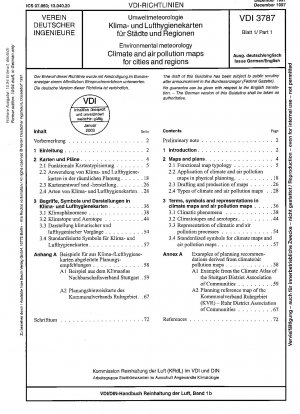VDI 3787 BLATT 1-1997
Umweltmeteorologie - Klima- und Lufthygienekarten fuer Staedte und Regionen
- Standard No.
- VDI 3787 BLATT 1-1997
- Release Date
- 1997
- Published By
- VDI - Verein Deutscher Ingenieure
- Status
- 2015-08
- Replace By
- VDI 3787 BLATT 1-2014
- Latest
- VDI 3787 Blatt 1-2015
- Scope
- Introduction Climate and aspects of air pollution are Standard components of most physical plans. As a rule@ the particular planning taskposes questions of site suitability and the effects or amenability of a project from the point of view of climate and air pollution: a) Is the site suitable in principle for the intended land use from the point of view of natural climatic phenomena (temperature@ Insolation@ air exchange relationships etc.) and of the prior loading in terms of air pollution (for example by emissions of inorganic or organic substances@ deposition of dust@ odour load)? How is it to be judged in comparison to possible alternative sites? b) What effect does an emitting use (road@ industrial works etc.) or construction which has a small climatic effect@ planting or other change to the surface of the earth have on neighboring land uses or uses which are sensitive in the area effected with regard to temperature changes@ formation of fog@ air exchange processes and emission loads@ and do they give rise to conflicts requiring regulation? c) What architectural requirements (building height@ orientation of structure@ propulsion of open sites@ surface configuration@ planting@ heat systems etc.) and restrictions on land use can be derived from the climatic and air pollution preconditions and from effects of the planned land use in order to avoid bioclimatic and air-pollution deterioration in the existing Situation and@ where possible@ to contribute to improving the climatic and air-pollution Situation for the planned area and the surrounding uses? d) What possibilities does physical planning have (possibly in Cooperation with statutory air pollution control measures) for the purpose of reducing recognized bioclimatic deficiencies and air-pollution loads in its area and to contribute to resolving acknowledged conflicts between uses which have a disturbing effect on climate and air pollution and those which are sensitive? (Eradicating existing areas of conflict@ S. Reiss-Schmidt 1987) It should also be possible@ inter alia@ to answer these questions by means of climate/air pollution maps. Before climate and air pollution maps are drawn up@ it is necessary firstly to analyze which factors in the district under review influence climate and air pollution. It is changes in energy tumover at the surface of the earth which are chiefly responsible for mesoclimatic and microclimatic changes. The former can be particularly pronounced in the case of so-called autochthonous (characteristic) weather situations@ i.e. when it is not the properties of an advected air mass which determines the microclimate@ but the energy conversion at the ground. Weather situations with relatively high wind speeds are also relevant for specific Prob? lems@ chiefly in the case of changes in the exchange of air near the ground {H@ Schirmer et al. 1993). It follows that the most important climatic factors are relief@ elevation@ land use@ surface structure@ nature of the soil@ Vegetation and any bodies of surface water. In addition@ the structures of emission and air pollution are important factors for air pollution problems. By analyzing the abovementioned factors@ it is possible to classify the areas of research into smaller units (so-called climatotopes or aerotopes): Climatic factors - Relief@ exposure - Altitude - Surface structure@ use - Soil condition - Vegetation - Surface water bodies Air pollution factors - Structure of emission - Structure of air pollution Climatotopes/aerotopes - Water bodies@ lakes - Open land - Forest - Inner-city green areas - Garden town - Suburban area - Agglomerated development - City Center - Industrial area - Commercial zone - Cold- and fresh-air lanes The spatial distribution of the factors of climate and air pollution@ and thus of the climatotopes/aerotopes is rendered more precise by the results of measurements and/or model calculations@ and the expression of the climatic elements and of the air-pollution Situation is quantified.
VDI 3787 BLATT 1-1997 history
- 2015 VDI 3787 Blatt 1-2015 Environmental meteorology - Climate and air pollution maps for cities and regions
- 2014 VDI 3787 BLATT 1-2014 Umweltmeteorologie - Klima- und Lufthygienekarten fuer Staedte und Regionen
- 1997 VDI 3787 BLATT 1-1997 Umweltmeteorologie - Klima- und Lufthygienekarten fuer Staedte und Regionen
- 1994 VDI 3787 Blatt 1-1994 Umweltmeteorologie - Klima- und Lufthygienekarten fuer Staedte und Regionen
